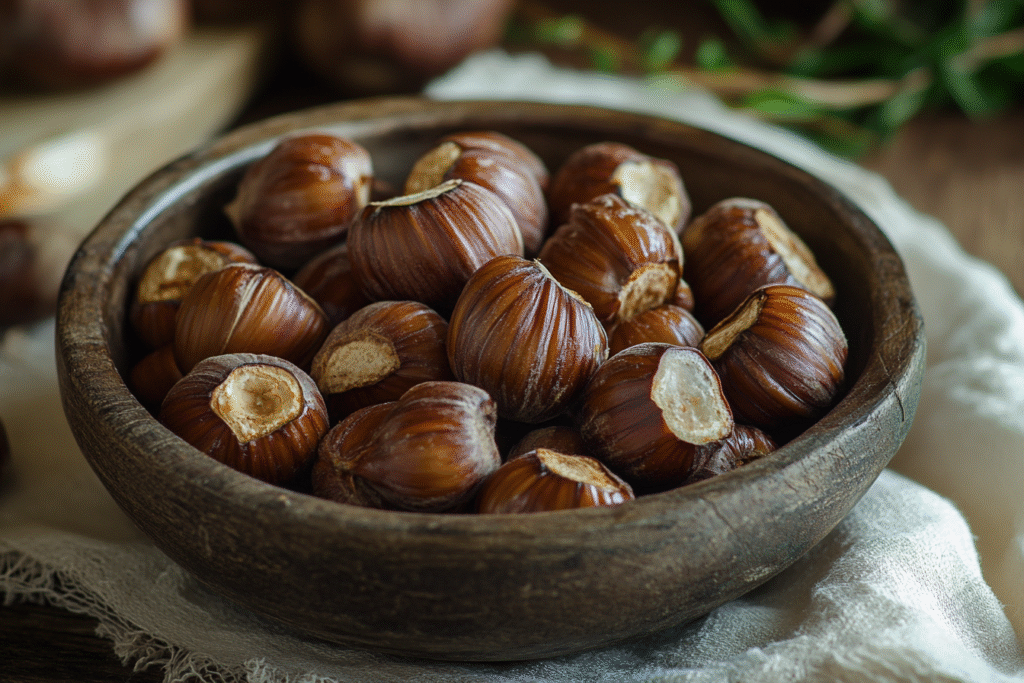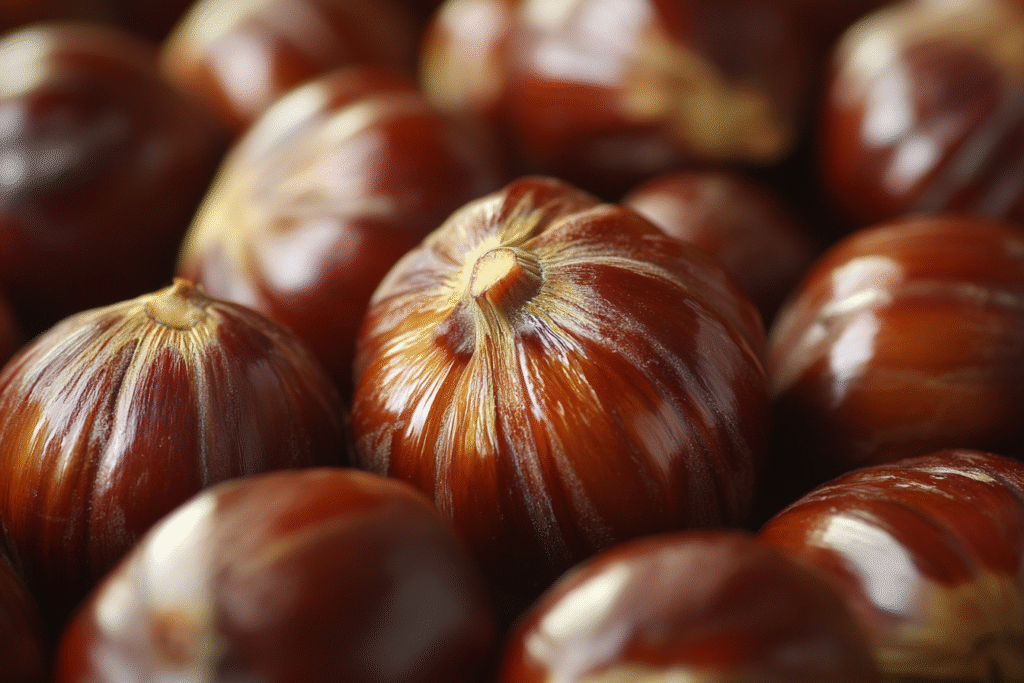The Timeless Comfort of Roast Chestnuts
Roast Chestnuts are one of winter’s simplest and most comforting treats, with their rich, sweet, and slightly nutty flavor filling the air as they roast. Whether you’ve stumbled upon street vendors selling them piping hot or enjoyed them at home around the holidays, roast chestnuts evoke a deep sense of nostalgia and cozy seasonal joy.
Chestnuts are unique among nuts: they’re soft, starchy, and mildly sweet when roasted, almost resembling the texture of a baked potato rather than the crunch of typical nuts. Their versatility makes them a perfect snack on their own, but they’re also wonderful when added to stuffing, salads, roasted vegetable dishes, or even pureed into soups and sauces.
The beauty of roasting chestnuts at home is that the process is straightforward and requires minimal preparation—no fancy equipment, no complex steps. The key to success is properly scoring the shells to allow steam to escape and peeling them while they’re still warm for the easiest, cleanest result.
This easy roast chestnuts recipe will guide you through everything you need to know for beautifully roasted, tender chestnuts every time.

Selecting the Best Chestnuts
Choosing good-quality chestnuts is essential for the best flavor and easiest peeling.
What to Look For:
- Shiny, Firm Shells: Avoid chestnuts with dull, wrinkled, or soft shells, which may indicate dryness or spoilage.
- Even Weight: Fresh chestnuts feel heavy for their size.
- No Rattling: Shake gently—if you hear rattling, the nut has dried out inside.
Types of Chestnuts:
- Sweet chestnuts are typically used for roasting.
- Horse chestnuts are not edible—make sure you purchase from a reliable source.

Recommended Equipment for Roasting Chestnuts
- Sharp Paring Knife: Essential for scoring the shells cleanly and safely.
- Roasting Pan or Baking Sheet: A simple, flat tray works perfectly.
- Clean Towel: Useful for wrapping the chestnuts after roasting to steam them slightly and make peeling easier.
- Bowl: For catching the shells as you peel.
Common Mistakes and How to Avoid Them
1. Not Scoring Deeply Enough
A shallow cut may not allow enough steam to escape, causing the chestnut to burst in the oven and making peeling more difficult.
2. Overcooking
Over-roasting can dry out the chestnuts and make them mealy. Stick to the recommended roasting time and check for doneness.
3. Peeling Too Late
Chestnuts peel best when still warm. If they cool completely, the shell and skin stick to the nut.
4. Skipping the Resting Step
Letting the chestnuts steam briefly after roasting helps loosen the inner skin and makes peeling much easier.
Ingredient Swaps and Flavor Variations
- Salted Chestnuts: Lightly sprinkle with sea salt before roasting for extra savory contrast.
- Cinnamon-Sugar Chestnuts: Toss warm chestnuts with a little cinnamon and sugar for a sweet twist.
- Herb Butter Glaze: After peeling, toss chestnuts in melted butter and fresh rosemary or thyme for a savory snack.
Chestnuts are naturally gluten-free, dairy-free, and vegan.
Prep-Ahead and Time-Saving Tips
- Pre-Score Chestnuts: You can score chestnuts up to 4 hours before roasting.
- Batch Roast: Roast extra and store peeled chestnuts in the refrigerator for up to 3 days to use in salads, stuffing, or soups.
- Freeze Peeled Chestnuts: Store peeled chestnuts in the freezer for up to 2 months for easy future use.
Flavor Boosters and Pairing Ideas
- Drizzle with Honey: A touch of sweetness enhances the natural flavor.
- Toss with Sea Salt and Olive Oil: For a savory, snackable finish.
- Serve with Cheese Boards: Chestnuts pair beautifully with soft cheeses like brie or goat cheese.
Pair With:
- Hot chocolate, mulled wine, spiced cider, or herbal tea.
- Holiday roasts, festive sides, or winter soups.
Easy Roast Chestnuts Recipe
Ingredients
- 500 g (about 1 lb) fresh chestnuts
- Optional: Sea salt, melted butter, honey, or fresh herbs for serving
Instructions
Step 1: Preheat the Oven
- Preheat your oven to 220°C (425°F).
Step 2: Score the Chestnuts
- Using a sharp paring knife, carefully cut an “X” on the flat side of each chestnut.
(Make sure to cut through the shell and slightly into the flesh.)
Step 3: Arrange for Roasting
- Place the scored chestnuts on a baking sheet in a single layer with the cut side facing up.
Step 4: Roast
- Roast for 20–25 minutes until the shells peel back at the cuts and the chestnuts are tender inside.
(You can check by inserting a small knife—if it slides in easily, they’re done.)
Step 5: Steam and Peel
- Remove from the oven and immediately wrap the hot chestnuts in a clean kitchen towel.
- Let them steam for 5–10 minutes to loosen the shells.
- Peel while still warm, removing both the hard outer shell and the papery inner skin.
Step 6: Serve
- Enjoy warm as a snack or toss with melted butter, sea salt, or honey for extra flavor.
Storage and Reheating
- Refrigerator: Store peeled chestnuts in an airtight container for up to 3 days.
- Freezing: Freeze peeled chestnuts for up to 2 months.
- Reheating: Gently warm in a skillet or oven before serving.
Troubleshooting Tips
- Chestnuts Hard to Peel? They’ve likely cooled too much. Try re-warming in the oven briefly to soften.
- Chestnuts Too Dry? May have been over-roasted. Roast slightly less time next batch.
- Chestnuts Exploding? Ensure deep, proper scoring to let steam escape.
Variations: Traditional Roasting vs. Boiling
- Roasting: Brings out nutty, caramelized flavors and is the most traditional method.
- Boiling: Easier to peel but lacks the deep roasted taste.
- Pan Roasting: Chestnuts can also be cooked in a covered pan over medium heat, often used by street vendors.
Roasting is the best method for that authentic, cozy winter aroma and flavor.
Serving Suggestions
- As a Snack: Serve warm with a sprinkle of sea salt or a drizzle of honey.
- On Cheese Boards: Pair with soft cheeses, nuts, and seasonal fruits.
- In Stuffing: Add peeled chestnuts to holiday stuffing for sweetness and texture.
- With Vegetables: Toss with roasted Brussels sprouts, green beans, or squash.
- In Soups: Puree into creamy chestnut soup for a hearty winter starter.
Roast chestnuts pair perfectly with mulled wine, spiced apple cider, or a simple cup of hot tea, making them a timeless, comforting treat on chilly days.


